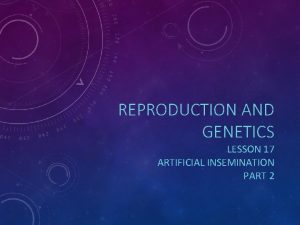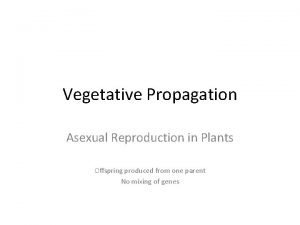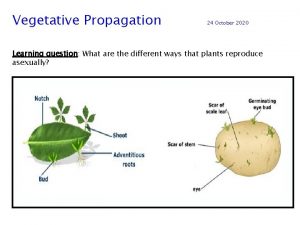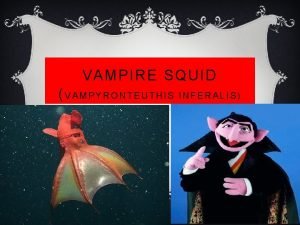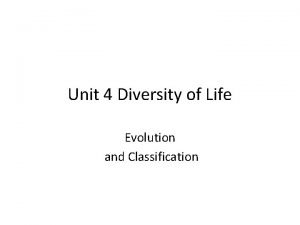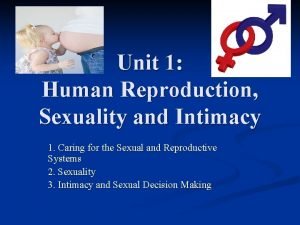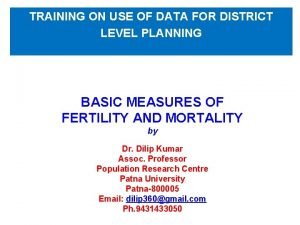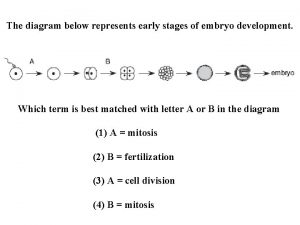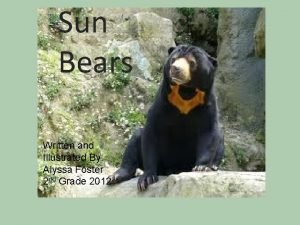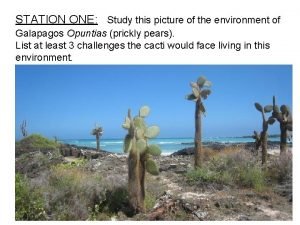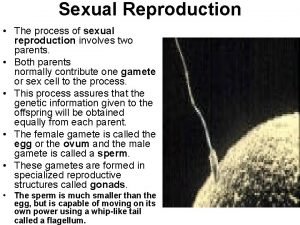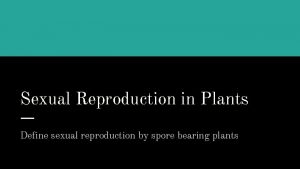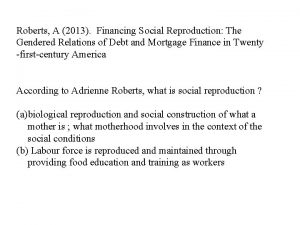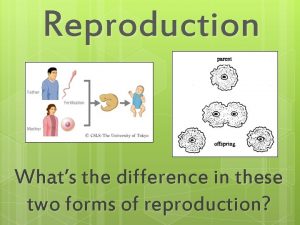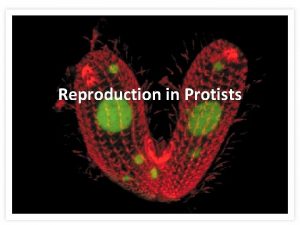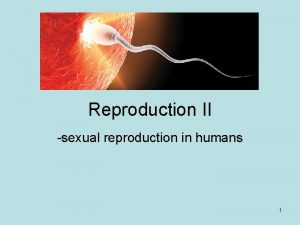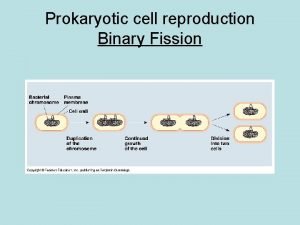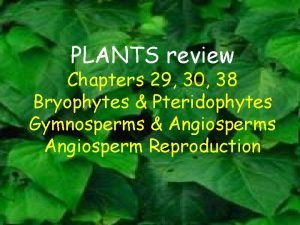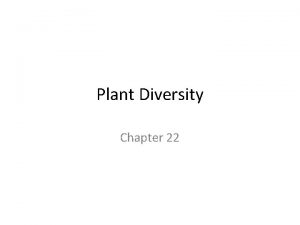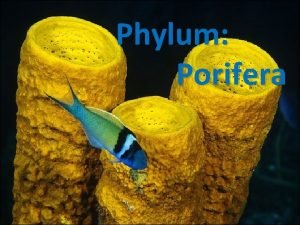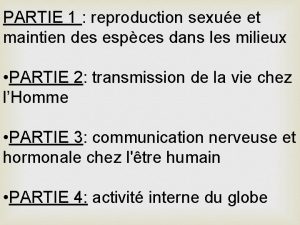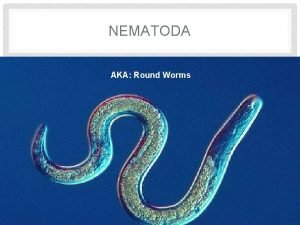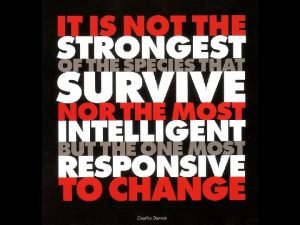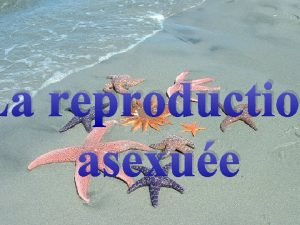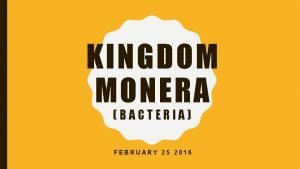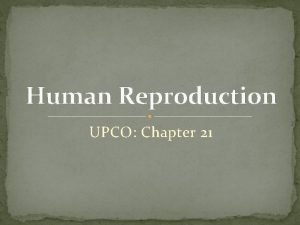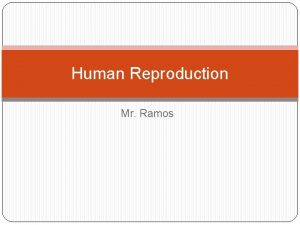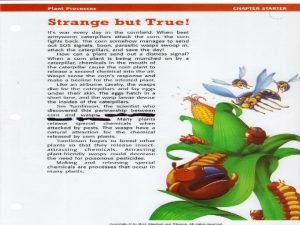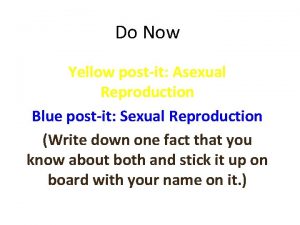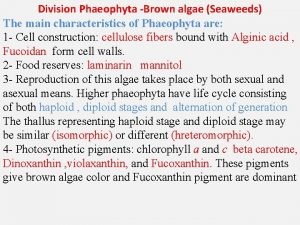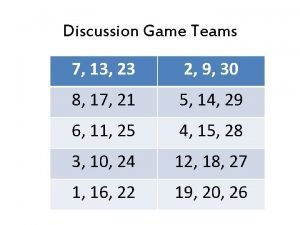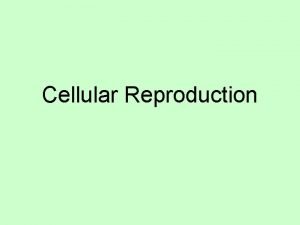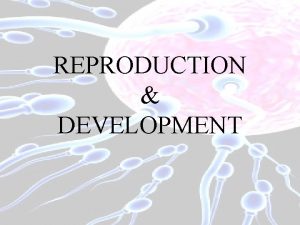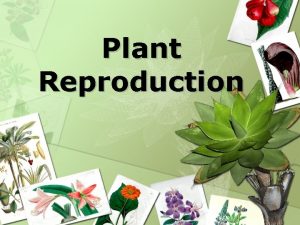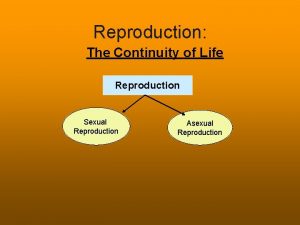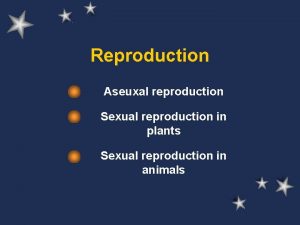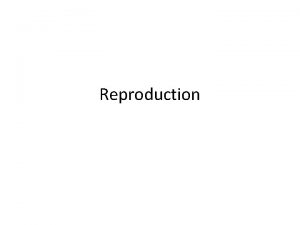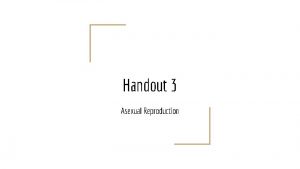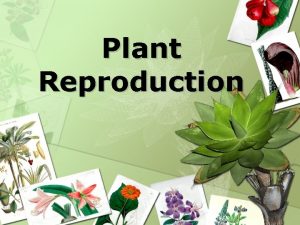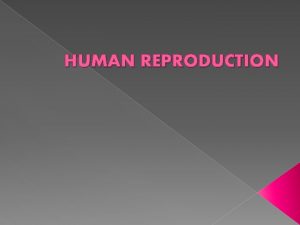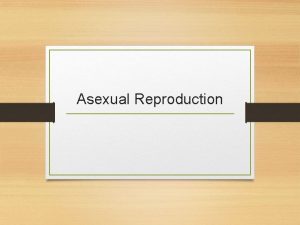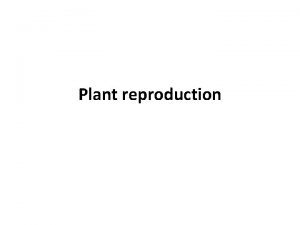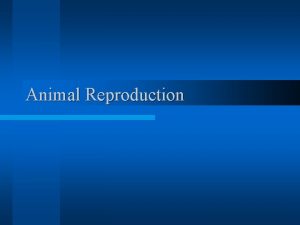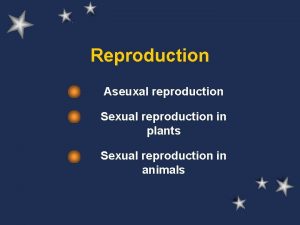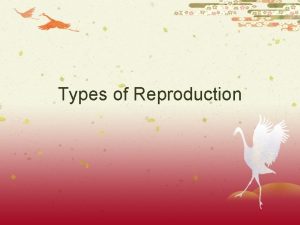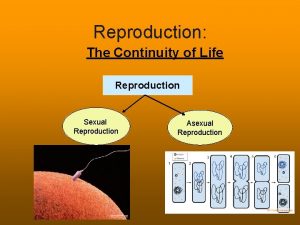Lesson Overview Reproduction Lesson Overview 28 3 Reproduction























































- Slides: 55

Lesson Overview Reproduction Lesson Overview 28. 3 Reproduction

Lesson Overview Reproduction THINK ABOUT IT Sexual reproduction can be dangerous. Just ask a male praying mantis—who may be devoured by his mate. Or an emperor penguin, who incubates an egg for months on Antarctic ice in temperatures far below zero. Or a female deer, who carries around her developing young for six months, while she runs from predators and seeks food for herself and the young she carries. Yet, most animal species engage in sexual reproduction during at least part of their life cycles. Why?

Lesson Overview Reproduction Asexual and Sexual Reproduction How do asexual and sexual reproduction in animals compare?

Lesson Overview Reproduction Asexual and Sexual Reproduction How do asexual and sexual reproduction in animals compare? Asexual reproduction requires only one parent, so individuals in favorable environmental conditions can reproduce rapidly. But since offspring produced asexually carry only a single parent’s DNA, they have less genetic diversity than do offspring produced sexually. Sexual reproduction maintains genetic diversity in a population by creating individuals with new combinations of genes.

Lesson Overview Reproduction Asexual Reproduction Many invertebrates and a few chordates can reproduce asexually. 1. Asexual reproduction requires only one parent, so individuals in favorable environmental conditions can reproduce rapidly. Since offspring produced asexually carry only a single parent’s DNA, they have less genetic diversity than do offspring produced sexually. Lack of genetic diversity can be a disadvantage to a population if its environment changes.

Lesson Overview Reproduction Asexual Reproduction Animals reproduce asexually in many ways. Some cnidarians divide in two. Some animals reproduce through budding, which produces new individuals as outgrowths of the body wall.

Lesson Overview Reproduction Asexual Reproduction Females of some species, such as a whiptail lizard, can reproduce asexually by producing eggs that develop without being fertilized. This process, called parthenogenesis, produces offspring that carry DNA inherited only from their mothers. This means of reproduction occurs in some crustaceans and insects but very rarely in vertebrates.

Lesson Overview Reproduction Sexual reproduction involves meiosis, the process that produces haploid reproductive cells, or gametes. Gametes carry half the number of chromosomes found in body cells. Typically, male animals produce small gametes, called sperm, which swim. Females produce larger gametes called eggs, which do not swim.

Lesson Overview Reproduction Sexual Reproduction When haploid gametes join during fertilization, they produce a zygote that contains the diploid number of chromosomes. 2. Sexual reproduction maintains genetic diversity in a population by creating individuals with new combinations of genes. Because genetic diversity is the raw material on which natural selection operates, sexually reproducing populations are better able to evolve and adapt to changing environmental conditions. However, sexual reproduction requires two individuals of different sexes, so the density of a population must be high enough to allow mates to find each other.

Lesson Overview Reproduction Sexual Reproduction In most animal species that reproduce sexually, each individual is either male or female. Among annelids, mollusks, and fishes, however, some species are hermaphrodites, which means that some individuals can be both male and female or can convert from one sex to the other. In some species, individuals can produce eggs and sperm at the same time. Usually, these animals don’t fertilize their own eggs, but exchange sperm with another individual. Some species, such as clownfish, may change from one sex to the other as they mature.

Lesson Overview Reproduction Reproductive Cycles A number of invertebrates have life cycles that alternate between sexual and asexual reproduction. Parasitic worms and cnidarians alternate between forms that reproduce sexually and forms that reproduce asexually.

Lesson Overview Reproduction Reproductive Cycles Parasitic worms such as blood flukes mature in the body of an infected person, reproduce sexually, and release embryos that pass out of the body in feces. If the embryos reach fresh water, they develop into larvae and infect snails, in which they reproduce asexually. Then the larvae are released, ready to infect another person.

Lesson Overview Reproduction Reproductive Cycles Many cnidarians alternate between two body forms: polyps that grow singly or in colonies and medusas that swim freely in the water.

Lesson Overview Reproduction Reproductive Cycles 3. In the life cycle of the jellyfish, polyps produce medusas asexually by budding.

Lesson Overview Reproduction Reproductive Cycles 4. The medusas reproduce sexually by producing eggs and sperm

Lesson Overview Reproduction Reproductive Cycles 5. After fertilization, the resulting zygote grows into a freeswimming larva.

Lesson Overview Reproduction Reproductive Cycles 6. The larva eventually attaches to a hard surface and develops into a polyp continuing the cycle.

Lesson Overview Reproduction Internal and External Fertilization How do internal and external fertilization differ?

Lesson Overview Reproduction Internal and External Fertilization How do internal and external fertilization differ? During internal fertilization, eggs are fertilized inside the body of the eggproducing individual. In external fertilization, eggs are fertilized outside the body of the eggproducing individual.

Lesson Overview Reproduction Internal Fertilization 7. Many aquatic and all land animals reproduce by internal fertilization: eggs are fertilized inside the body

Lesson Overview Reproduction Invertebrates that reproduce by internal fertilization range in complexity from sponges to arachnids. The eggs of sponges and some other aquatic animals are fertilized by sperm released by others of their species and taken in from the surrounding water. In many arthropod species, males deposit sperm inside the female’s body during mating.

Lesson Overview Reproduction Chordates Some fishes and amphibians, and all reptiles, birds, and mammals, reproduce by internal fertilization. In some amphibian species, males deposit “sperm packets” into the surrounding environment; females then pick up these packets and take them inside their bodies. In many other chordate species, males have an external sexual organ that deposits sperm inside the female during mating.

Lesson Overview Reproduction External Fertilization 8. A wide range of aquatic invertebrate and vertebrate reproduce by external fertilization, during which eggs are fertilized outside the body.

Lesson Overview Reproduction Invertebrates with external fertilization include corals, worms, and mollusks. These animals release large numbers of eggs and sperm into the water. Gamete release is usually synchronized with tides, phases of the moon, or seasons so that eggs and sperm are present at the same time. Fertilized eggs develop into free-swimming larvae that typically develop for a time before changing into adult form.

Lesson Overview Reproduction Chordates with external fertilization include most nonvertebrate chordates and many fishes and amphibians. In some fish species males and females spawn in a school, releasing large numbers of eggs and sperm into the water. Other fishes and many amphibians spawn in pairs. In these cases, the female usually releases eggs onto which the male deposits sperm.

Lesson Overview Reproduction Development and Growth Where do embryos develop?

Lesson Overview Reproduction Development and Growth Where do embryos develop? Animals may be oviparous, ovoviviparous, or viviparous.

Lesson Overview Reproduction Development and Growth After eggs are fertilized, the resulting zygote divides through mitosis and differentiates. This development occurs under different circumstances in different species. The care and protection given to developing embryos also varies widely.

Lesson Overview Reproduction Where Embryos Develop Embryos develop either inside or outside the body of the parent in various ways. Animals may be oviparous, ovoviviparous, or viviparous.

Lesson Overview Reproduction Oviparous Species 9. Oviparous species are those in which embryos develop in eggs outside the parents’ bodies. Most invertebrates, many fishes and amphibians, most reptiles, all birds, and a few odd mammals are oviparous.

Lesson Overview Reproduction Ovoviviparous Species In 10. ovoviviparous species, embryos develop within the mother’s body, but they depend entirely on the yolk sac of their eggs. The young do not receive any additional nutrients from the mother. The young either hatch within the mother’s body or are released immediately before hatching. They swim freely shortly after hatching. Guppies and other fishes in their family, along with some shark species, are ovoviviparous.

Lesson Overview Reproduction Viviparous Species 11. Viviparous species are those in which embryos obtain nutrients from the mother’s body through the placenta Viviparity occurs in most mammals and in some insects, sharks, bony fishes, amphibians, and reptiles.

Lesson Overview Reproduction Viviparous Species In viviparous insects, and in some sharks and amphibians, young are nourished by secretions produced in the mother’s reproductive tract. 12. the placenta—enables exchange of gases, nutrients, and wastes between mother and young.

Lesson Overview Reproduction How Young Develop Most newborn mammals and newly hatched birds and reptiles look a lot like miniature adults. In contrast, as invertebrates, nonvertebrate chordates, fishes, and amphibians develop, they undergo metamorphosis. Metamorphosis is a developmental process that leads to dramatic changes in shape and form.

Lesson Overview Reproduction Aquatic Invertebrates Many aquatic invertebrates have a larval stage, which looks nothing like an adult. These larvae often swim or drift in open water before undergoing metamorphosis and assuming their adult form. Members of some phyla, such as cnidarians, have a single larval stage. Other groups, such as crustaceans, may pass through several larval stages before they look like miniature adults.

Lesson Overview Reproduction Terrestrial Invertebrates 13. Some insects, such as chinch bugs, undergo gradual or incomplete metamorphosis. Immature forms, or 14. nymphs, resemble adults, but they lack functional sexual organs and some adult structures such as wings. As they molt several times and grow, nymphs gradually acquire adult structures.

Lesson Overview Reproduction Terrestrial Invertebrates 15. Other insects, such as butterflies, undergo complete metamorphosis. Larvae of these animals look nothing like their parents, and they feed in different ways. Larvae molt and grow, but change little in appearance. Then the larvae undergo a final molt and change into a pupa, the stage in which an insect larva develops into an adult. 16. During the pupal stage, the entire body is remodeled inside and out, and the adult that emerges looks like a completely different animal.

Lesson Overview Reproduction Terrestrial Invertebrates Control of metamorphosis in arthropods is accomplished by hormones. In insects that undergo complete metamorphosis, high levels of a juvenile hormone keep an insect in its larval form.

Lesson Overview Reproduction Terrestrial Invertebrates As the insect matures, its production of juvenile hormone decreases and eventually drops below a certain threshold. The next time the insect molts, it becomes a pupa. When no juvenile hormone is produced, the insect undergoes a pupa-to-adult molt.

Lesson Overview Reproduction Amphibians typically undergo metamorphosis that is controlled by hormones. This metamorphosis changes amphibians from aquatic young into terrestrial adults. Amphibian larvae are commonly called tadpoles. Frog tadpoles start out with flippers, gills, and a tail and mature into adults that have legs, lungs, and no tail.

Lesson Overview Reproduction Care of Offspring Animals’ care of their offspring varies from no care at all to years of nurturing. Most aquatic invertebrates and many fishes and amphibians release large numbers of eggs that they completely ignore. This reproductive strategy succeeds in circumstances favoring populations that disperse and grow rapidly.

Lesson Overview Reproduction Care of Offspring Other animals care for their offspring. Some amphibians incubate young in their mouth, on their back, or even in their stomach! Birds and mammals generally care for their young. Maternal care is an important mammalian characteristic, and the bond between mother and young is often very close.

Lesson Overview Reproduction Care of Offspring Males of many species also help care for young. Parental care helps young survive in crowded, competitive environments. Typically, species that provide intensive or long-term parental care give birth to fewer young than do species that offer no parental care.

Lesson Overview Reproduction Reproductive Diversity in Chordates How are terrestrial vertebrates adapted to reproduction on land?

Lesson Overview Reproduction Reproductive Diversity in Chordates How are terrestrial vertebrates adapted to reproduction on land? Reptiles, birds, and a few mammals have evolved amniotic eggs in which an embryo can develop outside its mother’s body, and out of water, without drying out. The three groups of mammals—monotremes, marsupials, and placentals— differ greatly in their means of reproduction and development, but all nourish their young with mother’s milk.

Lesson Overview Reproduction Reproductive Diversity in Chordates first evolved in water, so early chordate reproduction was suited to aquatic life. The eggs of most modern fishes and amphibians still need to develop in water, or at least in very moist places. As some vertebrate lineages left the water to live on land, they evolved a number of new reproductive strategies that enabled their fertilized eggs to develop somewhere other than in a body of water.

Lesson Overview Reproduction The Amniotic Egg 17. The amniotic egg provides a protected environment in which an embryo can develop out of water and is one of the most important vertebrate adaptations to life on land. found in Reptiles, birds, and a few mammals have evolved amniotic eggs.

Lesson Overview Reproduction The Amniotic Egg The amnion is a fluid-filled sac that surrounds and cushions the developing embryo. It produces a protected, watery environment.

Lesson Overview Reproduction The Amniotic Egg The chorion regulates the transport of oxygen from the surface of the egg to the embryo and the transport of carbon dioxide, one product of respiration, in the opposite direction.

Lesson Overview Reproduction The Amniotic Egg The yolk sac is a baglike structure that contains a yolk that serves as a nutrient-rich food supply for the embryo.

Lesson Overview Reproduction The Amniotic Egg The allantois stores the waste produced by the embryo. It later fuses with the chorion and serves as a respiratory organ.

Lesson Overview Reproduction Mammalian Reproductive Strategies Mammals have evolved various adaptations for reproducing and caring for their young. The three groups of mammals—monotremes, marsupials, and placentals—differ greatly in their means of reproduction and development, but all nourish their young with mother’s milk.

Lesson Overview Reproduction Monotremes 18. Reproduction in monotremes, such as the echidna, combines reptilian and mammalian traits. Like a reptile, a female monotreme lays soft-shelled, amniotic eggs that are incubated outside her body. The eggs hatch in about ten days. But like other mammals, young monotremes are nourished by milk produced by the mother’s mammary glands. Female monotremes secrete milk through pores on the surface of the abdomen.

Lesson Overview Reproduction Marsupials, such as wallabies, bear live young that usually complete their development in an external pouch. 19. Marsupial young are born at a very early stage of development, they crawl across their mother’s fur and attach to a nipple in her pouch, or marsupium. Inside the marsupium, the young spend months attached to a nipple, drinking milk and growing inside until they can survive independently.

Lesson Overview Reproduction Placentals 20. Placental mammals are nourished through a placenta before they are born and by their mother’s milk after they are born. The placenta allows the embryo to develop for a long time inside the mother, and to be born at a fairly advanced stage of development. Placental mammals are nourished through a placenta before they are born.
 Asexual reproduction cell division
Asexual reproduction cell division Hare lynx
Hare lynx Sexual and asexual reproduction venn diagram
Sexual and asexual reproduction venn diagram Lesson 17 reproduction
Lesson 17 reproduction Chapter 9 lesson 2 photosynthesis an overview
Chapter 9 lesson 2 photosynthesis an overview Lesson overview
Lesson overview Dahlia asexual reproduction
Dahlia asexual reproduction Vegetative reproduction plants
Vegetative reproduction plants Vampire squid
Vampire squid Geographical isolation example
Geographical isolation example A sexual reproduction in humans
A sexual reproduction in humans Examples of asexual reproduction
Examples of asexual reproduction Total fertility rate formula
Total fertility rate formula Phylum and class
Phylum and class The diagram below represents chromosomes in a zygote
The diagram below represents chromosomes in a zygote Life cycle of a sun bear
Life cycle of a sun bear Prickly pear reproduction
Prickly pear reproduction Chapter 20 sexual reproduction in animals packet answers
Chapter 20 sexual reproduction in animals packet answers A sexual reproduction involves
A sexual reproduction involves Define sexual reproduction
Define sexual reproduction Sexual reproduction and genetics section 1 meiosis
Sexual reproduction and genetics section 1 meiosis Social reproduction
Social reproduction Whats a sexual reproduction
Whats a sexual reproduction Human reproduction webquest
Human reproduction webquest Protist reproduction
Protist reproduction Male reproductive system in plants
Male reproductive system in plants Sexual reproduction in human
Sexual reproduction in human Prokaryotic reproduction
Prokaryotic reproduction Prokaryotic cell and eukaryotic cell similarities
Prokaryotic cell and eukaryotic cell similarities Monocots have __ cotyledon
Monocots have __ cotyledon Chapter 22 plant diversity answer key
Chapter 22 plant diversity answer key Origin of the word
Origin of the word Sea star anatomy
Sea star anatomy Schéma fécondation
Schéma fécondation Roundworms
Roundworms What is the selective pressure
What is the selective pressure Budding asexual reproduction
Budding asexual reproduction Example of asexual propagation
Example of asexual propagation Chapter 10 sexual reproduction and genetics
Chapter 10 sexual reproduction and genetics What is map reproduction
What is map reproduction Internal structure of lichen
Internal structure of lichen Are prokaryotes microscopic
Are prokaryotes microscopic Layering asexual reproduction
Layering asexual reproduction La reproduction asexuée
La reproduction asexuée La reproduction asexuée
La reproduction asexuée Monera
Monera Monera kingdom reproduction
Monera kingdom reproduction What is a negative reproduction
What is a negative reproduction Reproduction in humans
Reproduction in humans Human reproduction introduction
Human reproduction introduction Flower structure and reproduction
Flower structure and reproduction Pila fertilization
Pila fertilization Asexual
Asexual Brown algae class
Brown algae class Sfu canvs
Sfu canvs Down with kitchen slavery
Down with kitchen slavery



